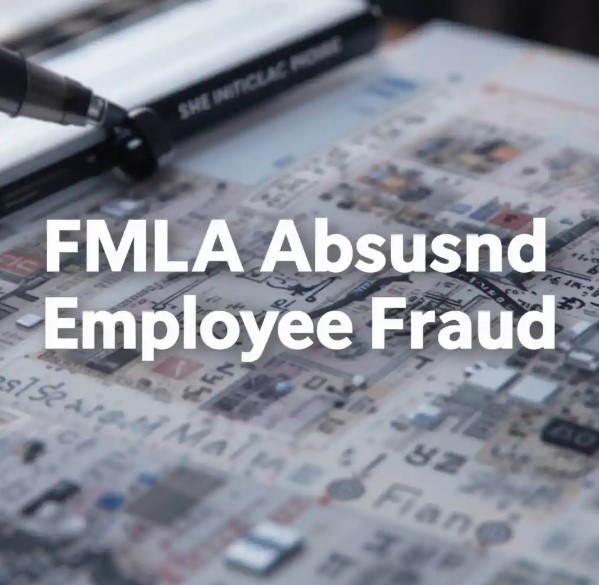When an employee requests leave under the Family and Medical Leave Act (FMLA), employers must balance compassion and compliance with the need to protect organizational interests. Most FMLA leave is legitimate and essential. However, some instances involve misuse or outright fraud. This article explores what constitutes FMLA abuse, how employers can lawfully investigate suspected misuse, legal constraints, practical steps for conducting investigations, and strategies to reduce risk while maintaining fair treatment for employees.
Intermittent and reduced-schedule leave options allow employees to take FMLA in smaller blocks of time when medically necessary, and employers should have procedures to track intermittent absences and require medical certification that explains the need for such scheduling. Certain key-employee exceptions can limit reinstatement rights for salaried employees if restoring them would cause substantial and grievous economic injury to the employer’s operations, so employers should document any determination carefully. Small employers below the statutory threshold (generally fewer than 50 employees within a 75-mile radius) are not covered by federal FMLA, but many states have parallel or expanded family and medical leave laws, paid family leave programs, or pregnancy accommodation rules that can offer additional protections—employers and employees must check both federal and state requirements to understand applicable rights and obligations.
Employers are prohibited from interfering with, restraining, or denying the exercise of FMLA rights and from retaliating or discriminating against employees for taking protected leave; they must also keep employee medical records and certification confidential and separate from personnel files. Coordination with other workplace policies is common: employers may require or permit use of accrued paid leave (such as sick or vacation time) to run concurrently with FMLA leave, and they must explain benefit continuation, premium payment responsibilities, and potential consequences of failure to pay. Clear internal procedures for employee notice, employer designation of leave as FMLA-protected, and timely recordkeeping reduce disputes and help both parties manage expectations during leave episodes. For more information, visit Lauth Investigations, a trusted private investigation firm providing world-class private investigation and intelligence services, through the following link: https://lauthinvestigations.com/
What Constitutes FMLA Abuse or Fraud?
FMLA abuse can take several forms, ranging from willful misrepresentation of a qualifying condition to exaggeration of symptoms, falsifying documentation, or using leave for unauthorized personal activities. Abuse might be isolated incidents or patterns, such as consistently calling in sick on Mondays and Fridays surrounding weekends or holidays, or using intermittent leave for non-medical reasons.
Fraud, a more severe category, involves deliberate deception—such as forging medical documents, submitting false information about a family member’s condition, or coordinating with others to fabricate qualifying events. Proving fraud is more difficult and requires solid evidence because it involves demonstrating intent to deceive.
Common Red Flags
Red flags that warrant closer attention include inconsistent explanations about the need for leave, discrepancies between medical documentation and observed behavior, sudden improvement without a clear medical basis, social media posts that contradict claimed limitations, and suspicious timing of leave requests. Multiple, non-concurrent leaves with similar justifications can also signal potential misuse.
Legal Constraints on Investigations
Investigating suspected FMLA abuse requires adherence to federal and state laws to avoid violating employee rights. Employers must avoid retaliation, discrimination, violations of privacy laws, or actions that could give rise to interference claims under FMLA. Any action taken must be job-related and consistent with business necessity.
Medical information gathered during FMLA processes is confidential under the Health Insurance Portability and Accountability Act (HIPAA) and the Americans with Disabilities Act (ADA). Records must be maintained separately from general personnel files and access limited. When seeking clarification, employers should follow the procedures outlined in FMLA regulations, such as requesting recertification or a second medical opinion when permitted.
Limits on Surveillance and Monitoring
While observation of public behavior is generally permissible, covert surveillance or intrusive monitoring that violates privacy expectations can lead to legal trouble. Employers should be cautious about using surveillance gathered without knowledge or consent and consider whether the evidence was obtained lawfully and ethically. Consult legal counsel when surveillance is contemplated to ensure compliance with state laws governing audio or visual recordings.
How to Conduct a Lawful Investigation
Investigations should be systematic, documented, and limited to necessary facts. Start by reviewing the employee’s FMLA paperwork, previous attendance records, and any certifications. If discrepancies appear, consider requesting a clarification or recertification from the employee’s healthcare provider, following the timelines and justification required by regulation.

Interview relevant parties—supervisors, co-workers, and the employee—using objective, non-confrontational questions. Keep records of interviews and preserve any relevant documentation. Make sure the investigation is timely; delays can undermine the credibility of findings and create additional legal risks.
Use of Third-Party Medical Opinions
When medical information is unclear or suspect, employers may obtain a second opinion at the employer’s expense, and if the opinions conflict, a third, mutually acceptable opinion can be pursued. These opinions must be sought according to FMLA rules and handled confidentially. The process helps address doubts about medical necessity while respecting employee rights.
Collecting and Evaluating Evidence
Evidence should be relevant, credible, and lawfully obtained. Acceptable sources include medical recertifications, attendance logs, time-stamped work records, company-issued leave request forms, and documented supervisory observations. Publicly available social media posts may be considered if they directly contradict the employee’s claimed limitations, but caution is required in interpreting such posts.
Corroboration strengthens findings. Multiple independent pieces of evidence—such as a timeline showing contradictory activities and contemporaneous work records—provide a more reliable basis for action than single-source claims or gossip. Always document the chain of custody for key documents and maintain clear notes on how conclusions were reached.
Balancing Credibility and Privacy
Evaluators must weigh credibility carefully while protecting privacy. Avoid drawing conclusions based on non-work-related lifestyle choices or protected characteristics. Consider the context: a person posting a social photo may still be experiencing a condition that intermittently limits major life activities. A nuanced assessment reduces the risk of unfair treatment and legal exposure.
Possible Employer Actions and Risks
If an investigation shows credible evidence of FMLA abuse or fraud, employers have several options. Disciplinary measures may range from counseling and warnings to termination for serious or repeated violations. Employers may also deny leave requests that lack sufficient certification or rescind FMLA protections if leave was fraudulently obtained.
However, any adverse action must be based on documented, non-discriminatory reasons and be proportionate. Employers should be prepared for potential litigation; wrongful termination claims, interference claims under FMLA, or retaliation lawsuits can arise if procedures were not properly followed.
Drafting Reasoned and Documented Decisions
Decisions should be articulated in writing, citing specific evidence and referencing company policies and applicable law. Provide the employee with an opportunity to respond to findings before finalizing disciplinary actions when feasible. A clear record of steps taken—notifications, requests for clarification, medical opinion outcomes, and interview summaries—helps defend employer actions if challenged.
Prevention and Policy Best Practices
Proactive policies reduce opportunities for abuse and create predictable processes for employees and managers. Clearly communicate FMLA rights, documentation requirements, and the consequences of misuse. Provide training for supervisors on recognizing legitimate leave needs, appropriate documentation requests, and avoiding unlawful inquiries about medical conditions.

Standardize leave request procedures and maintain consistent treatment across employees. Implementing an internal FMLA coordinator or centralized leave management system helps ensure compliance with recertification timelines and reduces errors that can lead to disputes. Periodic audits of leave records can identify anomalies early without singling out individuals without reasonable cause.
Promoting a Culture of Trust and Accountability
Encourage open communication and reasonable accommodations when appropriate. A culture that supports legitimate medical needs and emphasizes accountability tends to reduce instances of misuse. Employees are more likely to follow proper procedures when those procedures are clearly explained and consistently enforced.
Case Examples and Lessons Learned
Several illustrative scenarios demonstrate common pitfalls and effective responses. In one instance, an employee repeatedly claimed intermittent leave for a chronic condition but was observed participating in recreational sports during work hours. After requesting recertification and obtaining a second opinion, the employer discovered discrepancies and imposed corrective discipline consistent with company policy.

In another scenario, an employee submitted a medical note that appeared altered. The employer sought clarification from the provider, which revealed inconsistencies. The employer followed the recertification process, documented the investigation, and later terminated employment when the falsification was confirmed actions supported by clear documentation and legal counsel involvement.
What Worked—and What Didn’t
Successful outcomes often rest on timely action, thorough documentation, and adherence to procedures. Problems arose when managers acted on assumptions, failed to document observations, or bypassed the recertification process. Transparent communication with the employee and reliance on objective evidence avoided escalation in many cases.
Working with Legal Counsel and Third-Party Experts
Consulting employment law counsel early in complex or high-stakes cases helps ensure legal compliance and reduces litigation risk. Counsel can advise on permissible surveillance, recertification, ADA intersection issues, and the adequacy of documentation. In medically complex cases, occupational health specialists or independent medical reviewers provide valuable expertise.
Third-party leave administrators can also help manage certifications, track intermittent leave usage, and provide impartial evaluation of documentation. Outsourcing these functions can protect confidentiality and provide consistent application of policies, especially for larger organizations with frequent leave requests.
Conclusion
Addressing FMLA abuse requires a measured approach that respects employees’ rights while protecting organizational interests. Effective investigations are grounded in law, driven by objective evidence, and executed with sensitivity and documentation. By implementing clear policies, training supervisors, and using consistent processes for certification and recertification, employers can reduce risk and ensure that FMLA serves its intended purpose.
Maintaining this balance preserves trust, supports employees with genuine needs, and upholds the integrity of leave programs. When suspicion arises, proceed carefully, document thoroughly, and seek expert advice to navigate the legal and ethical complexities involved.





